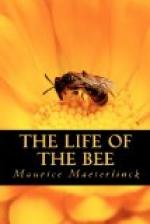[99]
But there is no warrant for the statement that the habits of the bees are unchanged. If we examine them with an unbiassed eye, and without emerging from the small area lit by our actual experience, we shall, on the contrary, discover marked variations. And who shall tell how many escape us? Were an observer of a hundred and fifty times our height and about seven hundred and fifty thousand times our importance (these being the relations of stature and weight in which we stand to the humble honey-fly), one who knew not our language, and was endowed with senses totally different from our own; were such an one to have been studying us, he would recognise certain curious material transformations in the course of the last two thirds of the century, but would be totally unable to form any conception of our moral, social, political, economic or religious evolution.
The most likely of all the scientific hypotheses will presently permit us to connect our domestic bee with the great tribe of the “Apiens,” which embraces all wild bees, and where its ancestors are probably to be found. We shall then perceive physiological, social, economic, industrial, and architectural transformations more extraordinary than those of our human evolution. But for the moment we will limit ourselves to our domestic bee properly so called. Of these sixteen fairly distinct species are known; but, essentially, whether we consider the Apis Dorsata, the largest known to us, or the Apis Florea, which is the smallest, the insect is always exactly the same, except for the slight modifications induced by the climate and by the conditions whereto it has had to conform.*
The scientific classification of the domestic bee is as follows:
Class ....... Insecta
Order ....... Hymenoptera
Family ....... Apidae
Genus ....... Apis
Species....... Mellifica
The term “Mellifica” is that of the Linnaean classification. It is not of the happiest, for all the Apidae, with the exception of certain parasites perhaps, are producers of honey. Scopoli uses the term “Cerifera “; Reaumur “Domestica “; Geoffroy “Gregaria.” The “Apis Ligustica,” the Italian bee, is another variety of the “Mellifica.”
The difference between these various species is scarcely greater than that between an Englishman and a Russian, a Japanese and a European. In these preliminary remarks, therefore, we will confine ourselves to what actually lies within the range of our eyes, refusing the aid of hypothesis, be this never so probable or so imperious. We shall mention no facts that are not susceptible of immediate proof; and of such facts we will only rapidly refer to some of the more significant.
[100]
Let us consider first of all the most important and most radical improvement, one that in the case of man would have called for prodigious labour: the external protection of the community.




